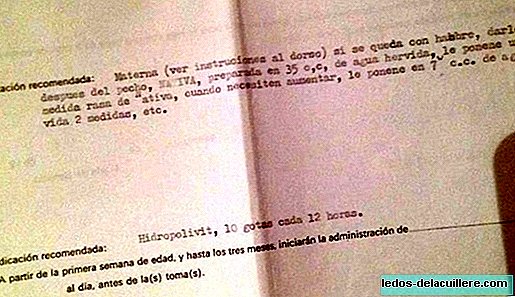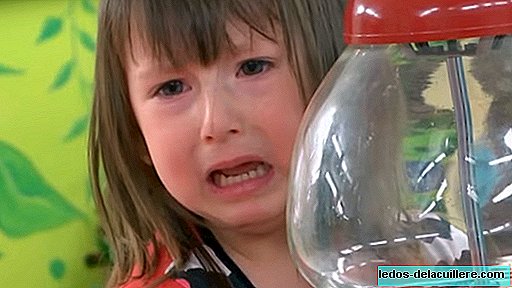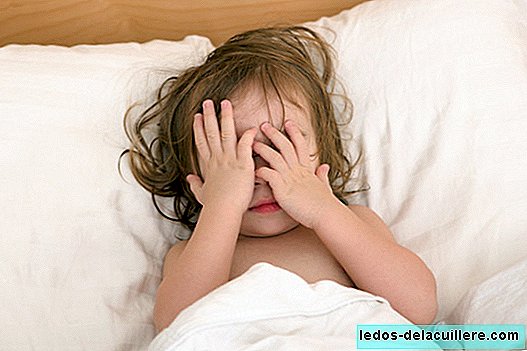A couple of years ago I wrote an entry explaining that it was a shame that most of our mothers couldn't help with breastfeeding problems now, either because they didn't have them (that their breastfeeding was successful and they didn't learn to solve problems that they didn't they had), either because many gave more bottles than tit and that's why they didn't discover the solutions about it.
The fact is that, for one reason or another, there are many tips that our mothers give us today that do not seem very appropriate or successful and now we know better why: we have read the indications given to recent mothers in 1978 and now we understand why they give us the advice they give us.
Baby feeding in 1978
The sheets that we are going to show you were delivered in the year 1978, in Castilla y León, to a woman who had just had her baby. It is difficult to say that what was said to this mother is what was said to all mothers, because that does not even happen now. Neither do pediatricians say the same if we compare them by autonomous communities, nor do they say the same if we compare them in the same city, nor do they say the same if we compare them within the same health center, nor do they in fact say the same if we compare the Pediatrician in a doctor's office in the morning and who is sitting in the same office in the afternoon.
Therefore, although it serves as a curious example of those times, I dare not say that this is what was said to all mothers at that time, although I dare to say that sure it was said to a large majority, especially if we take into account that even now there are pediatricians who deliver sheets that do not differ too much from these, and have passed almost 40 years.

Recommended food: Maternal (see instructions on the back) if you are hungry, give it after the breast, NATIVA, prepared in 35 cc of boiled water, they put a level measure of Nativa, when they need to increase, they put it in 70 cc of boiled water two measures, etc.
The recommended feeding for the baby was breast milk, but there didn't seem to be much help in case there were problems. Instead of saying something like "If you stay hungry, go back to check the baby's breastfeeding," the mothers took the message that, if the baby cried, they should give him artificial milk, so that the main The solution to a breastfeeding problem was to assume that the problem was irresolvable and that we had to go to infant formula.
More on breastfeeding at that time
For breastfeeding, women were given several rules that they should follow and that, with what we now know, we can say that they probably helped many of the lactations to fail. As the solution was also included, which was to give artificial milk, we already know why most babies of that time ended up taking a bottle.


The shots should be every three hours or more, and the tendency should be to extend the time to breastfeed even more every four hours. Given that today it is considered that the best way to breastfeed a baby is on demand, and that this means that a baby can take shots every hour, sometimes at half an hour, sometimes at two , but rarely every three or four, it is clear that they talked about a pattern of minimums that caused most babies to go hungry.
Add him that at night they should sleep 5 to 6 hours, after a full day when they had barely been able to eat, and you already had babies practically malnourished and crying too often to be considered properly fed.
In addition, women the breasts should be washed with boiled water before breastfeeding the baby, so that relatively annoying situations and unnecessary obligations were added, because of that of "now it's time to breastfeed, but I'm in the middle of the street and I can't give it until I get home and wash my breasts ".
Then, with the child crying, more hungry than a mouse in a church, the mother finally put him to the chest and began to count the 10 minutes after which I had to separate it from the chest to calm him down as good as he could, probably convinced that he had already eaten enough and cried for another reason, or that his milk was simply not good and the child was hungry.
With the exception of some baby expert in eating a lot in a short time, most babies would hardly achieve with such guidelines increase the 175 grams of weight they marked, so for them, since "that indicates that the child does not take enough", there was the solution of mixed breastfeeding.
Other strange tips of the time
As if that were not enough, the month of life the thing was complicated a little more, because a tablespoon of orange juice began to be fasted, mixed with water and sweetened with half a teaspoon of sugar, and then wait for 15-20 minutes, even if you were hungry, to breastfeed or bottle.
Now we know that the ideal is that a baby does not drink anything other than milk until at least 4 months of life, although it is recommended according to the latest guidelines that this do not happen until six months of life (only milk until six months, and thereafter complementary feeding), at the time when you are prepared to eat new foods (and we also know that sugar is not too recommended as food, so it is better not to add it without need).
But food was not everything. They had to bathe us every day, before meals, at a temperature of 30 to 32 degrees. Now it is recommended that the water is a little hotter and that the bath is not daily (although this is not to pull the hair).
In addition, they recommended that they put us to sleep on their stomachs because at that time it was considered to be the safest position, when now that position is totally contraindicated. As you well know, babies should sleep on their backs (with their backs to the mattress) with their heads tilted, since in this way the risk is much lower.
Curious, right?
PS: Thanks to Vega for passing me the images of the instructions given to her mother-in-law in her day.












